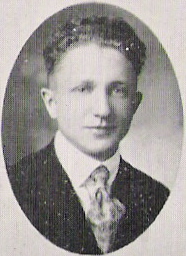George Kingsley Zipf
George Kingsley Zipf | |
|---|---|
 1917 photograph from the 1919 Annual of the Freeport High School, Freeport, Illinois | |
| Born | January 7, 1902 |
| Died | September 25, 1950 (aged 48) |
| Nationality | American |
| Alma mater | Harvard College |
| Known for | Zipf's law |
| Spouse | Joyce Waters Brown Zipf |
| Children | Robert Zipf, Katherine Sandstrom, Joyce Harrington, Henry Zipf |
| Scientific career | |
| Fields | Statistics, linguistics |
George Kingsley Zipf (/ˈzɪf/;[1] January 7, 1902 – September 25, 1950), was an American linguist and philologist who studied statistical occurrences in different languages.[2]
Zipf earned his bachelors, masters, and doctoral degrees from Harvard University, although he also studied at the University of Bonn and the University of Berlin.[2] He was chairman of the German department and university lecturer (meaning he could teach any subject he chose) at Harvard University.[2] He worked with Chinese and demographics, and much of his effort can explain properties of the Internet, distribution of income within nations, and many other collections of data.[3]
Zipf's law[edit]
He is the eponym of Zipf's law, which states that while only a few words are used very often, many or most are used rarely,
where Pn is the frequency of a word ranked nth and the exponent a is almost 1. This means that the second item occurs approximately 1/2 as often as the first, and the third item 1/3 as often as the first, and so on. Zipf's discovery of this law in 1935 was one of the first academic studies of word frequency.[4]
Although he originally intended it as a model for linguistics, Zipf later generalized his law to other disciplines. In particular, he observed that the rank vs. frequency distribution of individual incomes in a unified nation approximates this law, and in his 1941 book, "National Unity and Disunity" he theorized that breaks in this "normal curve of income distribution" portend social pressure for change or revolution.[citation needed]
See also[edit]
Bibliography[edit]
- Zipf, George Kingsley (1932): Selected Studies of the Principle of Relative Frequency in Language. Cambridge (Mass.).
- (1935): The Psycho-Biology of Language. Cambridge (Mass.).
- (1941): National unity and disunity
- (1946): The P1 P2/D Hypothesis: On the Intercity Movement of Persons. American Sociological Review, vol. 11, Dec, pp. 677
- (1949): Human behavior and the principle of least effort
References[edit]
- ^ Leitch, Matthew (2010), A Pocket Guide to Risk Mathematics: Key Concepts Every Auditor Should Know, John Wiley & Sons, p. 62, ISBN 9780470971468.
- ^ a b c "Zipf Dies After 3 - Month Illness", The Harvard Crimson, September 27, 1950.
- ^ Saichev, A. I.; Malevergne, Yannick; Sornette, Didier (2009), Theory of Zipf's Law and Beyond, Lecture notes in economics and mathematical systems, vol. 632, Springer, p. 1, ISBN 9783642029462.
- ^ Baayen, R. Harald (2002), Word Frequency Distributions, Text, Speech and Language Technology, vol. 18, Springer, p. 13, ISBN 9781402009273.
- 1902 births
- 1950 deaths
- American philologists
- American statisticians
- Harvard College alumni
- Harvard University faculty
- Harvard University Department of German faculty
- American academics of German literature
- Quantitative linguistics
- Bibliometricians
- American people of German descent
- 20th-century American mathematicians
- 20th-century philologists

